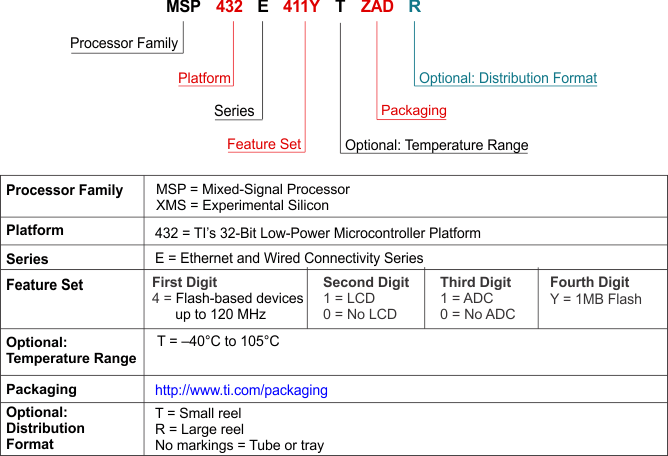ZHCSH09 October 2017 MSP432E401Y
PRODUCTION DATA.
- 1器件概述
- 2Revision History
- 3Device Characteristics
- 4Terminal Configuration and Functions
-
5Specifications
- 5.1 Absolute Maximum Ratings
- 5.2 ESD Ratings
- 5.3 Recommended Operating Conditions
- 5.4 Recommended DC Operating Conditions
- 5.5 Recommended GPIO Operating Characteristics
- 5.6 Recommended Fast GPIO Pad Operating Conditions
- 5.7 Recommended Slow GPIO Pad Operating Conditions
- 5.8 GPIO Current Restrictions
- 5.9 I/O Reliability
- 5.10 Current Consumption
- 5.11 Peripheral Current Consumption
- 5.12 LDO Regulator Characteristics
- 5.13 Power Dissipation
- 5.14 Thermal Resistance Characteristics, 128-Pin PDT (TQFP) Package
- 5.15
Timing and Switching Characteristics
- 5.15.1 Load Conditions
- 5.15.2 Power Supply Sequencing
- 5.15.3 Reset Timing
- 5.15.4
Clock Specifications
- 5.15.4.1 PLL Specifications
- 5.15.4.2 PIOSC Specifications
- 5.15.4.3 Low-Frequency Oscillator Specifications
- 5.15.4.4 Hibernation Low-Frequency Oscillator Specifications
- 5.15.4.5 Main Oscillator Specifications
- 5.15.4.6 Main Oscillator Specification WIth ADC
- 5.15.4.7 System Clock Characteristics With USB Operation
- 5.15.5 Sleep Modes
- 5.15.6 Hibernation Module
- 5.15.7 Flash Memory
- 5.15.8 EEPROM
- 5.15.9 Input/Output Pin Characteristics
- 5.15.10 External Peripheral Interface (EPI)
- 5.15.11 Analog-to-Digital Converter (ADC)
- 5.15.12 Synchronous Serial Interface (SSI)
- 5.15.13 Inter-Integrated Circuit (I2C) Interface
- 5.15.14 Ethernet Controller
- 5.15.15 Universal Serial Bus (USB) Controller
- 5.15.16 Analog Comparator
- 5.15.17 Pulse-Width Modulator (PWM)
- 5.15.18 Emulation and Debug
-
6Detailed Description
- 6.1 Overview
- 6.2 Functional Block Diagram
- 6.3 Arm Cortex-M4F Processor Core
- 6.4 On-Chip Memory
- 6.5
Peripherals
- 6.5.1 External Peripheral Interface (EPI)
- 6.5.2 Cyclical Redundancy Check (CRC)
- 6.5.3 Advanced Encryption Standard (AES) Accelerator
- 6.5.4 Data Encryption Standard (DES) Accelerator
- 6.5.5 Secure Hash Algorithm/Message Digest Algorithm (SHA/MD5) Accelerator
- 6.5.6 Serial Communications Peripherals
- 6.5.7 System Integration
- 6.5.8 Advanced Motion Control
- 6.5.9 Analog
- 6.5.10 JTAG and Arm Serial Wire Debug
- 6.5.11 Peripheral Memory Map
- 6.6 Identification
- 6.7 Boot Modes
- 7Applications, Implementation, and Layout
- 8器件和文档支持
- 9机械、封装和可订购信息
8.2 器件命名规则
为了指出米6体育平台手机版_好二三四开发周期所处的阶段,TI 为所有微处理器 (MPU) 和支持工具的米6体育平台手机版_好二三四型号分配了前缀。每个器件都具有以下三个前缀中的其中一个:XMS、PMS 或 MSP。这些前缀代表了米6体育平台手机版_好二三四开发的发展阶段,即从工程原型直到完全合格的生产器件和工具。
器件开发进化流程:
- XMS试验器件不一定代表最终器件的电气规范标准,并且可能不使用生产组装流程。
- PMS 原型器件不一定是最终器件模型,并且不一定符合最终电气标准规范。
- MSP完全合格的器件模型的生产版本。
试验器件和工具在供货时附带如下免责声明:
“开发中的米6体育平台手机版_好二三四用于内部评估用途。”
生产器件和开发支持工具已进行完全特性描述,并且器件的质量和可靠性已经完全论证。TI 的标准保修证书适用。
预测显示原型器件的故障率大于标准生产器件。由于这些器件的预计最终使用故障率仍未定义,米6体育平台手机版_好二三四 (TI) 建议不要将它们用于任何生产系统。只有合格的米6体育平台手机版_好二三四器件将被使用。
TI 器件的命名规则也包括一个带有器件系列名称的后缀。这个后缀表示封装类型(例如,ZAD)和温度范围(例如,“空白”是默认的商业级温度范围)。Figure 8-1 显示了完整器件名称的解读图例。
有关器件的订购部件号,请参阅本文档的封装选项附录、ti.com.cn 或者与您的 TI 销售代表联系。
有关裸片器件命名规则标记 的 其他说明,请参阅具体器件的《器件勘误表》。
 Figure 8-1 器件命名规则
Figure 8-1 器件命名规则